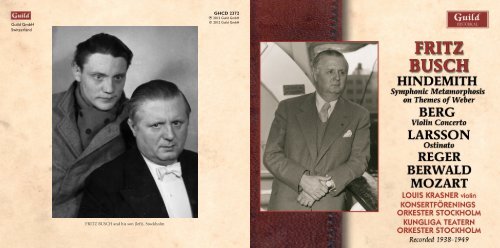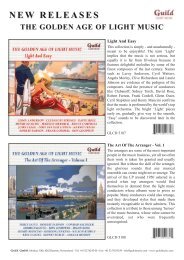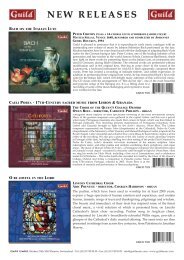GHCD 2372 Guild GmbH Switzerland FRITZ BUSCH and his son (left)
GHCD 2372 Guild GmbH Switzerland FRITZ BUSCH and his son (left)
GHCD 2372 Guild GmbH Switzerland FRITZ BUSCH and his son (left)
Create successful ePaper yourself
Turn your PDF publications into a flip-book with our unique Google optimized e-Paper software.
<strong>Guild</strong> <strong>GmbH</strong><br />
<strong>Switzerl<strong>and</strong></strong><br />
<strong>GHCD</strong> <strong>2372</strong><br />
2012 <strong>Guild</strong> <strong>GmbH</strong><br />
© 2012 <strong>Guild</strong> <strong>GmbH</strong><br />
<strong>FRITZ</strong> <strong>BUSCH</strong> <strong>and</strong> <strong>his</strong> <strong>son</strong> (<strong>left</strong>), Stockholm
1<br />
2<br />
3<br />
4<br />
5<br />
<strong>FRITZ</strong> <strong>BUSCH</strong> (1890–1951)<br />
WOLFGANG AMADEUS MOZART (1756-1791)<br />
‘Così fan tutte’ KV 588 – Overture 3:50<br />
– Kungliga Teatern orkester Stockholm<br />
Kungliga Teatern Stockholm 30 March 1940<br />
PAUL HINDEMITH (1895-1963)<br />
Symphonic Metamorphosis on Themes of Carl Maria von Weber<br />
I. Allegro 4:01<br />
II. Scherzo (Tur<strong>and</strong>ot): Moderato – Lively 8:32<br />
III. Andantino 3:48<br />
IV. March 4:36<br />
– Konsertförenings orkester Stockholm<br />
Stockholm Konserthuset, 4 December 1949<br />
A GUILD HISTORICAL RELEASE<br />
• Remastering: Peter Reynolds<br />
• Final master preparation: Reynolds Mastering, Colchester, Engl<strong>and</strong><br />
• Cover photo: Fritz Busch on board a ship of the Swedish-American Line<br />
(Photo – Jack Calderwood, New York)<br />
• Photos from The Tully Potter Collection (p. 4) <strong>and</strong> the BrüderBuschArchiv in the<br />
Max-Reger-Institut, Karlsruhe<br />
• Design: Paul Brooks, Design <strong>and</strong> Print, Oxford<br />
• Art direction: <strong>Guild</strong> <strong>GmbH</strong><br />
• Executive co-ordination: <strong>Guild</strong> <strong>GmbH</strong><br />
• We appreciate the kind help <strong>and</strong> assistance of Gert Schäfer (Schlangenbad) <strong>and</strong><br />
Prof. Dr. Klaus Schöler (Kreuztal).<br />
6<br />
7<br />
8<br />
ALBAN BERG (1885-1935)<br />
Concerto for Violin <strong>and</strong> Orchestra ‘To the memory of an angel’<br />
I. Andante – Allegretto 10:38<br />
II. Allegro, ma sempre rubato, frei wie eine Kadenz – Adagio 14:26<br />
– LOUIS KRASNER violin<br />
– Konsertförenings orkester Stockholm<br />
Stockholm Konserthuset, 20 April 1938<br />
LARS-ERIK LARSSON (1908-1986)<br />
Ostinato (Third Movement) from Symphony No.2, Op.17 8:29<br />
– Konsertförenings orkester Stockholm<br />
Stockholm Konserthuset, 4 December 1949<br />
■<br />
■<br />
■<br />
<strong>Guild</strong> <strong>GmbH</strong>, Moskau 314b, 8262 Ramsen, <strong>Switzerl<strong>and</strong></strong><br />
Tel: +41 (0) 52 742 85 00 Fax: +41 (0) 52 742 85 09 (Head Office)<br />
<strong>Guild</strong> <strong>GmbH</strong>, PO Box 5092, Colchester, Essex CO1 1FN, Great Britain<br />
e-mail: info@guildmusic.com World WideWeb-Site: http://www.guildmusic.com<br />
WARNING: Copyright subsists in all recordings under t<strong>his</strong> label. Any unauthorised broadcasting, public<br />
performance, copying or re-recording thereof in any manner whatsoever will constitute an infringement of such<br />
copyright. In the United Kingdom licences for the use of recordings for public performance may be obtained from<br />
Phonographic Performances Ltd., 1 Upper James Street, London W1F 9EE.
Fritz Busch, Stockholm 1951<br />
Konserthuset, Stockholm (1930 post card)<br />
9<br />
10<br />
11<br />
MAX REGER (1873-1916)<br />
Phantasie über den Choral “Wie schön leucht’t uns der Morgenstern”,<br />
Op.40 No.1 (orch. Fritz Busch)<br />
I. Pesante – Andante sostenuto (ma non troppo) 9:08<br />
II. Fugue. Allegro vivace 3:39<br />
– Konsertförenings orkester Stockholm<br />
Stockholm Konserthuset, 4 December 1949<br />
FRANZ BERWALD (1796-1868)<br />
‘Estrella di Soria’ – Overture 7:02<br />
– Konsertförenings orkester Stockholm<br />
Stockholm Konserthuset, 29 September 1946<br />
(a piece more than a dozen times performed by Busch), 3 followed by Mozart’s great C major Symphony. The<br />
second half consisted of Ostinato, the third (<strong>and</strong> final) movement from Lars-Erik Lars<strong>son</strong>’s Second Symphony<br />
(1937) which was performed regularly as an independent piece by Busch <strong>and</strong> other conductors after Lars<strong>son</strong> had<br />
discarded the other two movements, <strong>and</strong> Hindemith’s Metamorphosis of Themes by Weber, a composition from<br />
as recent as 1944, which Busch had already programmed in Malmö on 3 November 1949 <strong>and</strong> which received a<br />
particularly fine rendering in Stockholm. The performance of Fritz Busch’s own orchestration of Max Reger’s<br />
Chorale Fantasia on “Wie schön leucht’t uns der Morgenstern” op. 40, No. 1, one of <strong>his</strong> few orchestrational efforts<br />
which he had written in Denmark in 1937, is not mentioned in the concert programme, it may have been recorded<br />
during a rehearsal sequence.<br />
T<strong>his</strong> was not the end of Busch’s activities in Sweden – the last time he came to Stockholm was in April <strong>and</strong><br />
May 1951, four months before <strong>his</strong> death.<br />
© Jürgen Schaarwächter, 2012<br />
1 The rehearsals of 30 April to 2 May 1951, together with the performance of 2 May 1951, have been released in 1979 on LP on license<br />
from the Sveriges Radio by the Discophilia label.<br />
2 The overture, together with Lars<strong>son</strong>’s Ostinato <strong>and</strong> Hilding Rosenberg’s Oriental Suite Djufar, was performed at an all-Swedish<br />
orchestral concert (in aid of Swedish seamen).<br />
3 A broadcast recording of the overture, in inferior sound, has survived from Chicago, from January 1947.<br />
6<br />
Fritz Busch <strong>and</strong> Ida Frankenstein, Stockholm, October 1947<br />
3
Fritz Busch’s first visit to Sweden dates from March 1932. Two concerts with the Konsertförenings orkester<br />
were scheduled for t<strong>his</strong> month, on 9 <strong>and</strong> 13 March, the programmes consisting solely of music from the<br />
German-Austrian Classical-Romantic tradition (Mozart, Beethoven, Schubert, Weber, Bruckner). By t<strong>his</strong><br />
time Busch had an increasing schedule as a guest conductor, much to the annoyance of the Dresden State Opera,<br />
whose General Music Director he had been from 1922.<br />
It was to take until 1936 that Busch returned to Stockholm as a conductor – in April of t<strong>his</strong> year he conducted<br />
three concerts, now with a repertoire ranging from a H<strong>and</strong>el Concerto grosso via Berlioz’s Benvenuto Cellini <strong>and</strong><br />
Wagner’s Tannhäuser Overtures to Mahler’s Second Symphony. It was in 1937 that Busch became the orchestra’s<br />
chief conductor (as successor to Václav Talich), <strong>and</strong> remained in t<strong>his</strong> position until 1940.<br />
During the period of three years, Busch conducted more than seventy concerts in Stockholm, with an<br />
unusual breadth of repertoire for him, ranging from a Bach Suite to Ibert’s Saxophone Concerto, from Falla’s<br />
Nights in Spanish Gardens to Elgar’s Enigma Variations, from Henrik Melcher Melchers’ Violin Concerto to an<br />
aria from Debussy’s L’enfant prodigue. Several times he programmed choral-orchestral works such as Verdi’s<br />
Requiem <strong>and</strong> Beethoven’s Ninth (each twice), Brahms’ Deutsches Requiem or the first Act from Die Walküre.<br />
A special focus was on Sc<strong>and</strong>inavian <strong>and</strong> 20th century music – Berwald, Wirén, Sibelius, Stenhammar, Nielsen,<br />
Rosenberg, Pergament, Hallnäs, Liljefors <strong>and</strong> many others featured in <strong>his</strong> Stockholm programmes – sadly hardly<br />
any of their music having survived from the Busch broadcasts.<br />
Fritz Busch conducted Alban Berg’s Violin Concerto (1935) only once ever, <strong>and</strong> t<strong>his</strong> performance happily<br />
has survived (though as the sole item of the concert of 20 April 1938 that also comprised H<strong>and</strong>el’s Concerto<br />
grosso in G major op. 3, No. 3 <strong>and</strong> Beethoven’s Fourth<br />
Symphony). His partner, Louis Krasner (1903–1995),<br />
a former pupil of Carl Flesch, had premiered the work<br />
two years previously in Barcelona <strong>and</strong> was later a<br />
renowned specialist in contemporary music, regularly<br />
performing music by Joseph Achron <strong>and</strong> Alfredo<br />
Casella <strong>and</strong> premiering amongst others Schoenberg’s<br />
Violin Concerto <strong>and</strong> music by Roger Sessions, Henry<br />
Cowell <strong>and</strong> Roy Harris.<br />
On 15 February 1940 Busch conducted the<br />
premiere performance of a new production of Così<br />
fan tutte, directed for stage by <strong>his</strong> <strong>son</strong> Hans Peter,<br />
Louis Krasner<br />
Carl Ebert’s assistant at the Glyndebourne Opera<br />
Festival. The nineteen performances in t<strong>his</strong> sea<strong>son</strong><br />
conducted by Busch (seven more were to follow in<br />
1946 <strong>and</strong> another seven in 1951) were an unanimous<br />
success, Busch being awarded a comm<strong>and</strong>er of the<br />
Royal Vasa Order on 29 February. But the situation<br />
became increasingly threatening – on 9 April the<br />
Buschs had to realize that Norway <strong>and</strong> Denmark had<br />
been occupied by the Nazis. Hence the couple, who<br />
had made Denmark their new home, had to make other arrangements, <strong>and</strong> Grete Busch recalls her husb<strong>and</strong><br />
having been much more hesitant than ever before – annulling existing engagements, having currently no secure<br />
future prospects, <strong>and</strong> even more having to leave <strong>his</strong> two married daughters in Europe, in France <strong>and</strong> Denmark<br />
respectively. Since they were not able to take all their belongings with them, Busch <strong>left</strong> an amount of <strong>his</strong> music<br />
with the orchestra, hence signalling that he would return as soon as possible. For 24 June 1940 the Buschs<br />
had booked flights to Moscow, from where they went, first on the Trans-Siberian Express, then by ship from<br />
Vladivostok to Tsuruga, <strong>and</strong>, after another train ride, again by ship, t<strong>his</strong> time on the elegant MS Kamakura Maru,<br />
from Yokohama to San Francisco, where they arrived on 6 July. From here Fritz Busch wrote to <strong>his</strong> brother Adolf:<br />
“I don’t know whether you feel like I – the more blows of fate you experience, the quieter you grow.” In spite<br />
of Adolf ’s suggestion to come over to New York, the Buschs departed by the end of August for their intended<br />
destination, Buenos Aires, which was to be the centre of their life from 1940 to 1945.<br />
Busch returned to Stockholm soon after the Second World War, <strong>his</strong> first concert with the Konsertförenings<br />
orkester taking place on 29 September 1946. It is from t<strong>his</strong> concert that the final item of the current CD has<br />
survived on tape. Franz Berwald was a composer Busch several times turned to <strong>and</strong> it is with t<strong>his</strong> composer’s<br />
Sinfonie sérieuse that Busch’s most substantial rehearsal sequences (in fact the total of three full-size rehearsals<br />
covering close on two <strong>and</strong> a half hours) have survived. 1 Busch programmed the overture to Estrella di Soria at<br />
least five times (including in Uppsala <strong>and</strong> Malmö), <strong>and</strong> another recording of the overture in a performance from<br />
the Carnegie Hall from 11 April 1949 has survived in the Swedish Radio Archive. 2<br />
After in 1947 Busch had returned to Stockholm solely as an opera conductor (of Verdi’s Macbeth, in eight<br />
performances), audiences had to wait until 30 November 1949 for Busch to return to Sweden; t<strong>his</strong> very concert<br />
was repeated on 4 December <strong>and</strong> on t<strong>his</strong> occasion recorded for broadcast. T<strong>his</strong> time the programme was even<br />
more varied, <strong>and</strong> its second half has survived on tape. The concert opened with Verdi’s Luisa Miller overture<br />
4 5

















